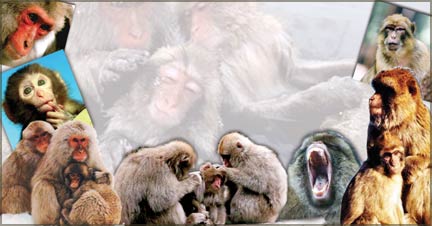|
observer |
|
|
|
|
|
OTHER LINKS |

|

|

|
|
|
|
|
The troop leader usually has two or three male sub-leaders who assist him in managing and defending the troop. Rank among the male monkeys is very stable. The offspring of high ranking macaques inherit the mother's position. However, it doesn't pay to be the first born because the younger offspring are usually ranked higher than the older ones.
There are strong social bonds between the members of the troop. Generally, the females remain with the troop their entire lives. The troop members could be seen grooming each other and living in harmony. They share the responsibility of bringing up their offspring.
The male macaques mature between the ages of four and five years and the females between the ages of three and five. The peak period in which births are recorded is from April-June and May through September.
After five to six months of pregnancy, the female delivers one baby with whom she forms a strong bond that lasts a lifetime. The baby macaque is weaned only when it's well into its second year. It starts to toddle at 20 days and climb at one month. It's able to ride on its mother's back instead of being carried about, by this time.
What they eat and their behaviour
Japanese Macaques are omnivorous, but are primarily fruigivorous, eating mainly fruits, seeds, tender leaves, flowers and tree bark. In the winter season, they also eat bird eggs, insects and small crabs.
They have large cheek pouches in which they store food. Japanese Macaques are very smart and in fact, researchers claim that apart from humans and racoons, they may be the only other animals that wash their food before eating.
Barbary Macaques
The best known old world monkey species, the Barbary Macaques are the only primates that live freely in Europe. Even though they are commonly referred to as Barbary apes, they are true monkeys and not apes.
Once found throughout northern Africa and Southern Europe, today Barbary Macaques are found mostly in Gibralta, Algeria, Morocco, and Tunisia, in isolated forest fragments. They dwell in forests of cedar, pine and oak. The earliest offshoot of the genus Macaca, the Barbary Macaques were probably introduced to Gibralta by the Romans or the Moors.
What they look like
They are medium sized monkeys averaging 75 cm (30 in) in height and weighing around 13 kg (29 lbs). They have dark pink faces and yellow, brown, to grey coats with a lighter underside.
Their front limbs are longer than the rear ones. The males are larger than the females. Unlike other monkeys, the Barbary macaques have no tails. They have only traces of a tail or stumps.
Social habits and behaviour
Barbary Macaques are gregarious monkeys, forming mixed groups of several male and several female troops, numbering 10-30 individuals. The hierarchy is determined by the lineage of the lead female.
They have strong social bonds and peacefully co-exist with others. They are considered to be different than other monkeys because the males help in caring for the young. The males spend time with the young macaques, grooming them and playing with them.
The female gives birth to one baby after 174 to 192 days of gestation. The macaques mature by the time they reach three years and are able to reproduce.
Barbary Macaques are diurnal (day time) creatures and are active during the day hunting for food. They are mostly herbivorous, surviving on leaves to roots and fruits.
They also eat insects. These macaques are equally at home on the ground as on the trees. They usually travel about on all fours, but occasionally stand erect to survey the territory for any threats from predators.
Barbary Macaques are today under severe threat as their habitats are being destroyed. Even though the population is now estimated to be around 2,000, in Gibraltar, they are said to be declining. This is mainly due to the fact that from 1915-1991, these macaques were under the care of British authorities.
In fact, a special official was appointed to look into the welfare and protection of these macaques. Following the withdrawal of the British from Gibraltar, the government of Gibraltar took over the responsibility of protecting this species.
The popular belief was that as long as these macaques existed on Gibraltar, the territories will remain under British rule.










